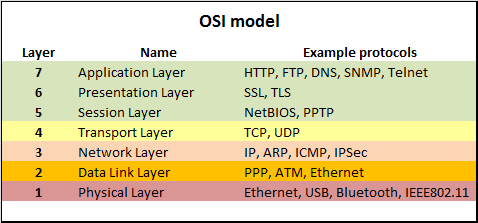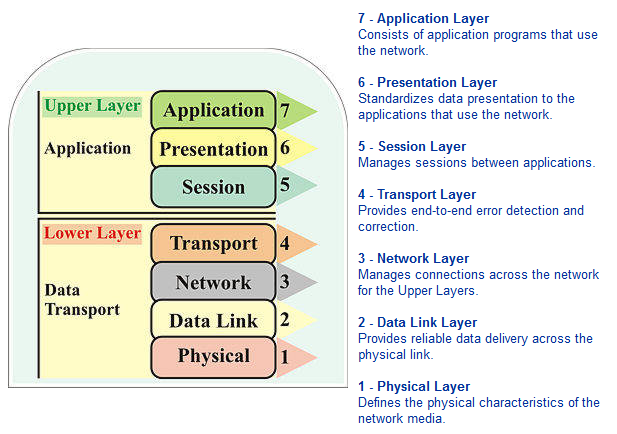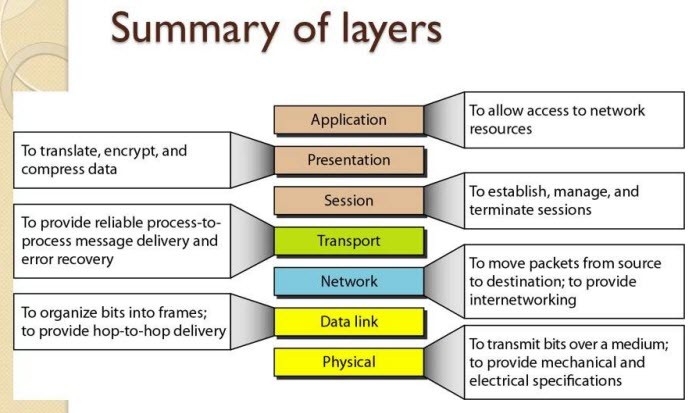The terms "network layer" or "network model" are often used in networking.
And the network layer is the third level of the Open Systems Interconnection Model (OSI Model) and the layer that provides data routing paths for network communication.
The OSI (Open Systems Interconnection) model describes a standardization of the functionalities in a communication system via abstract layers.
Each layer defines an own set of functionalities during the communication between network devices and only communicates with the layer above and below.

As the figure showed above, network models define a set of network layers and how they interact. The different network model depends on what organization or company started them.
The most important two are:
TCP/IP Model - This model is sometimes called the DOD model since it was designed for the department of defense. It is also called the internet model because TCP/IP is the protocol used on the internet.
OSI Network Model - The International Standards Organization (ISO) has defined a standard called the OSI (Open Systems Interconnection) reference model. This is a 7 layer architecture and is described further in the next section.
ISO/OSI Network Model, the standard model for networking protocols and distributed applications, is the International Standard Organization's Open System Interconnect (ISO/OSI) model. It defines seven network layers.

Characteristics of the OSI Layers
The seven layers of the OSI reference model can be divided into two categories: upper layers and lower layers.
The Upper Layers of the OSI model deal with application issues and generally are implemented only in software. The highest layer, the application layer, is closest to the end user. Both users and application layer processes interact with software applications that contain a communications component. The term upper layer is sometimes used to refer to any layer above another layer in the OSI model.
The Lower Layers of the OSI model handle data transport issues. The physical layer and the data link layer are implemented in hardware and software. The lowest layer, the physical layer, is closest to the physical network medium (the network cabling, for example) and is responsible for actually placing information on the medium.

More Details-The OSI Network Model Standard
The OSI network model layers are arranged here from the lower levels starting with the physical (hardware) to the higher levels.
- Physical Layer - The actual hardware.
- Data Link Layer - Data transfer method (802x ethernet). Puts data in frames and ensures error free transmission. Also controls the timing of the network transmission. Adds frame type, address, and error control information. IEEE divided this layer into the two following sublayers.
- Logical Link control (LLC) - Maintains the Link between two computers by establishing Service Access Points (SAPs) which are a series of interface points. IEEE 802.2.
- Media Access Control (MAC) - Used to coordinate the sending of data between computers. The 802.3, 4, 5, and 12 standards apply to this layer. If you hear someone talking about the MAC address of a network card, they are referring to the hardware address of the card.
- Network Layer - IP network protocol. Routes messages using the best path available.
- Transport Layer - TCP, UDP. Ensures properly sequenced and error free transmission.
- Session Layer - The user's interface to the network. Determines when the session is begun or opened, how long it is used, and when it is closed. Controls the transmission of data during the session. Supports security and name lookup enabling computers to locate each other.
- Presentation Layer - ASCII or EBCDEC data syntax. Makes the type of data transparent to the layers around it. Used to translate date to computer specific format such as byte ordering. It may include compression. It prepares the data, either for the network or the application depending on the direction it is going.
- Application Layer - Provides services software applications need. Provides the ability for user applications to interact with the network.

Many protocol stacks overlap the borders of the seven layer model by operating at multiple layers of the model. File Transport Protocol (FTP) and telnet both work at the application, presentation, and the session layers.
The Internet, TCP/IP, DOD Model
This model is sometimes called the DOD model since it was designed for the department of defense It is also called the TCP/IP four layer protocol, or the internet protocol. It has the following layers:
- Link - Device driver and interface card which maps to the data link and physical layer of the OSI model.
- Network - Corresponds to the network layer of the OSI model and includes the IP, ICMP, and IGMP protocols.
- Transport - Corresponds to the transport layer and includes the TCP and UDP protocols.
- Application - Corresponds to the OSI Session, Presentation and Application layers and includes FTP, Telnet, ping, Rlogin, rsh, TFTP, SMTP, SNMP, DNS, your program, etc.
Please note the four layer TCP/IP protocol. Each layer has a set of data that it generates.
- The Link layer corresponds to the hardware, including the device driver and interface card. The link layer has data packets associated with it depending on the type of network being used such as ARCnet, Token ring or ethernet. In our case, we will be talking about ethernet.
- The network layer manages the movement of packets around the network and includes IP, ICMP, and IGMP. It is responsible for making sure that packages reach their destinations, and if they don't, reporting errors.
- The transport layer is the mechanism used for two computers to exchange data with regards to software. The two types of protocols that are the transport mechanisms are TCP and UDP. There are also other types of protocols for systems other than TCP/IP but we will talk about TCP and UDP in this document.
- The application layer refers to networking protocols that are used to support various services such as FTP, Telnet, BOOTP, etc. Note here to avoid confusion, that the application layer is generally referring to protocols such as FTP, telnet, ping, and other programs designed for specific purposes which are governed by a specific set of protocols defined with RFC's (request for comments). However a program that you may write can define its own data structure to send between your client and server program so long as the program you run on both the client and server machine understand your protocol. For example when your program opens a socket to another machine, it is using TCP protocol, but the data you send depends on how you structure it.



















































































































